- Bundling the purchasing volume from manufacturers in order to negotiate good conditions for members
- Selection of manufacturers that meet high quality standards and reliably supply watches, movements and accessories

The beginnings of Union Hologère
In 1886, the name was changed to Schweizerische Uhrmacher-Genossenschaft (SUG), and in 1901 it finally became the Union Horlogère. From this point onwards, the name Alpina was also used for selected, particularly high-quality movements.

In 1917, Union Horlogère became the Alpina Deutsche Uhrmacher-Genossenschaft GmbH in Berlin for the German market, from which the Dugena brand (Deutsche Uhrmacher Genossenschaft Alpina) later emerged, as the name Alpina was no longer allowed to be used in Germany after the Second World War. Of course, this was by no means the end of the company’s history, but we will limit ourselves here to the early period up to around 1915.

In the early years, Union Horlogère began to develop its own calibers, which were then produced in the Duret & Colonnaz movement factory in Geneva. The movements were finished at J. Straub & Cie. in Biel and assembled in watches. Jacob Straub himself also developed a whole series of movements for the cooperation. He was also the one who initially had the Alpina brand protected for two of his high-quality lever movements.
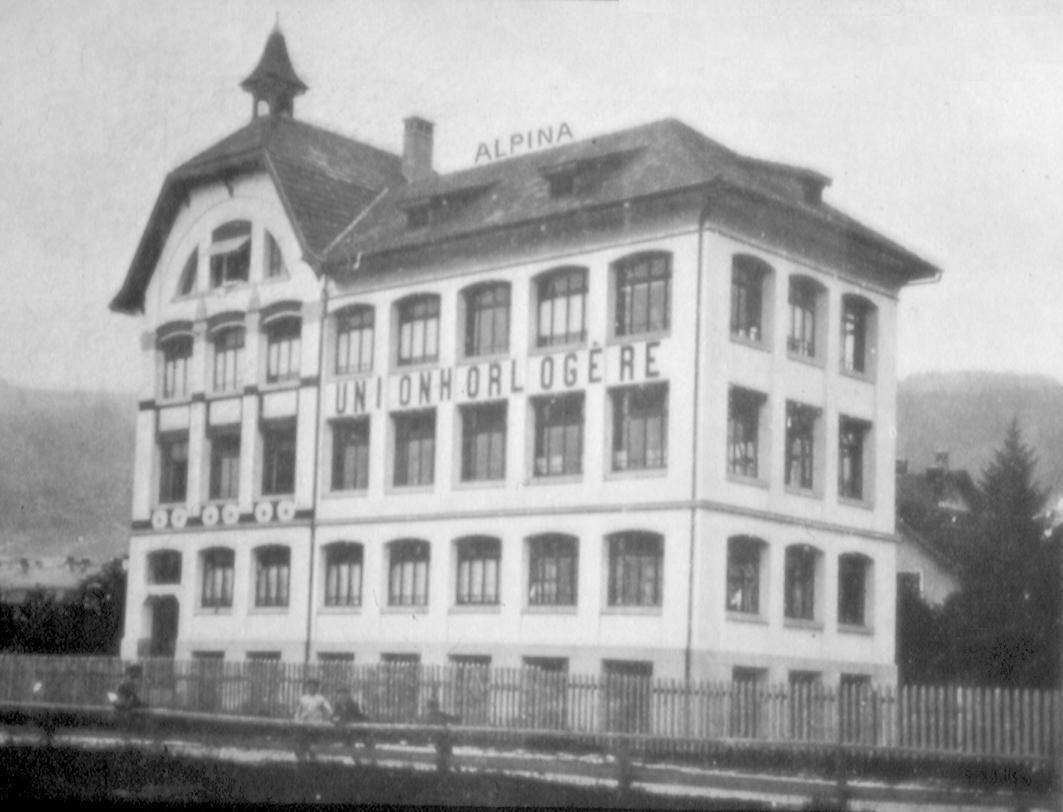
Over time, numerous other manufacturers also supplied watches or watch parts to UH, e.g. Kurth Frères, Moeri and the American companies Gruen and Hamilton.
The Flume main catalog 1912
Before we return to Union Horlogère and Alpina, a brief excursion into the history of another company from the watch industry: Rudolf Flume founded a wholesale business for watch and jewelry spare parts as well as tools for watchmakers and goldsmiths in Berlin in 1887. For the company’s 25th anniversary in 1912, Flume published a main catalog with 1150 pages as an anniversary edition. A heavyweight with thousands of pictures, some in color, showing everything from A to Z that made watchmakers’ and jewelers’ hearts beat faster at the time.


Among other things, this catalog contains a chapter on spare parts for stencil watches. Stencil watches are watches with movements whose individual parts are largely machine-made so that spare parts fit without reworking. This was by no means the case for all movements on the market around 1912!

Flume later became known for his movement identifiers, which enabled generations of watchmakers to identify movements and order suitable spare parts. I have reported on the Flume movement identifiers here.
Now back to the Union Horlogère. In the Flume main catalog from 1912, there is a double-page overview of UH movements from this period:

Let’s take a closer look at the illustrations. I can also provide real movement pictures for some of them. Interestingly, almost all the movements do not simply have caliber numbers, but descriptive names such as “Stella”.
Movements for ladies’ pocket watches
The first two rows contain smaller movements that were used for ladies’ pocket watches:

- Alpina
12 lignes, Swiss lever escapement, 15 jewels, small seconds, crown wheel and ratchet wheel underneath bridges, crown winding with pusher, bimetallic screw balance with Breguet hairspring.
The crown wheel bridge of these movements always seems to be marked Alpina. This could be one of the movements mentioned above, which were marked with the name Alpina by Jacob Straub.
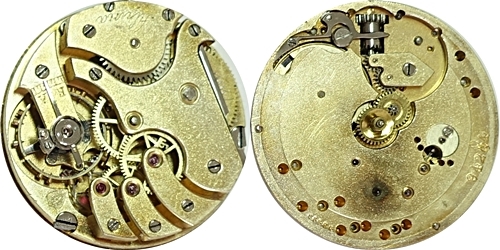

- Eminent
Swiss lever escapement, bimetallic screw balance, 15 jewels.
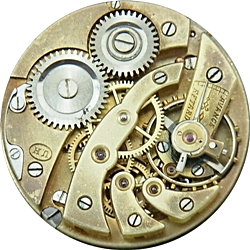
- Lilie 1 (with two different bridge shapes)
11 1/2 lignes, cylinder escapement, 10 jewels, no seconds, crown winding with pusher.

- Lilie 2
11 1/4 lignes, cylinder escapement, 4 jewels, no seconds, crown winding with pusher.

-
- Stella
11 1/2 lignes, cylinder escapement, 10 jewels, no seconds, crown winding with pusher.
- Stella

- Mila
11 3/4 lignes, cylinder escapement, 10 jewels, no seconds, crown winding with pusher. The movement shown below is missing the minute wheel on the dial side.

Movements for men’s pocket watches row 1/5
This is followed by the larger movements for men’s pocket watches:

- Alpina 19/20
Swiss lever escapement, 15 jewels, swan-neck fine regulator.

- Chronometer Alpina
Swiss lever escapement, 15 jewels, swan-neck fine regulator, crown and ratchet wheels underneath bridges.

This high-quality movement was the basis for watch production by UH in Glashütte, Germany. The Präcisions-Uhrenfabrik Alpina Glashütte G.m.b.H. was founded for this purpose in 1909. From 1912, the Swiss base movement was equipped in Glashütte with typical features of Glashütte movements:
Engraved balance cock, Glashütte hairspring stud, compensation balance with gold screws, (different) swan-neck fine regulator, gold escape wheel and Glashütte gold anchor with hidden pallets, movement number.
It is easy to imagine that local manufacturers such as A. Lange & Söhne were not exactly thrilled about this Swiss immigrant. However, the company ran into financial difficulties as early as 1915 and was dissolved in 1922. So it remains only a minor episode in the history of Glashütte watches.

- Cap
18 1/2 lignes, cylinder escapement, 10 jewels, small seconds, crown winding with pusher.
The CAP mark registered by the Union Horlogère in 1910 is also stamped on some, but not all, of these movements. The Swiss cross and the number 13537 can be found on the dial side, referring to the Swiss patent CH13537, which was granted to Simon, Burger & Gressot in 1897. It describes a device for positioning the balance cock relative to the cylinder wheel. Simon, Burger & Gressot may also have built the movement for the UH.
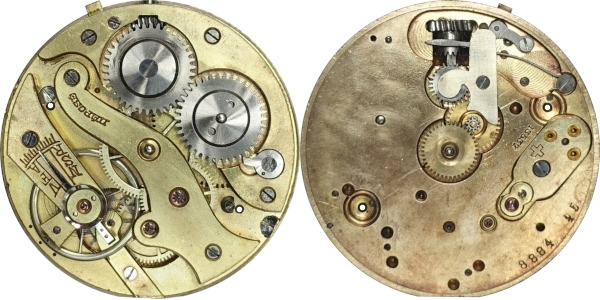
- Elite
Swiss lever escapement, bimetallic screw balance, crown winding with lever, 15 jewels.

The Elite movement listed in the catalog is a Lépine (open face) version, which means that the winding stem and the small seconds are in a straight line. There is also a Savonnette (hunter) version of the Elite, in which the winding stem and small seconds are arranged at a 90 degree angle to each other:
- Elite Sav.
19 lines, Swiss lever escapement, bimetallic screw balance with Breguet hairspring, 15 jewels, small seconds, crown winding with lever.

Movements for men’s pocket watches row 2/5

- Elite 17
Swiss lever escapement, screw balance, 15 jewels, small seconds, crown winding.

- Lilie
Cylinder escapement. - Lilie-Anker
Swiss lever escapement.

- Lloyd
Cylinder escapement, 10 jewels, small seconds, crown winding with pusher.

Movements for men’s pocket watches row 3/5

- Lord
Swiss lever escapement. - Maxim
- Moulin D
Swiss lever escapement. - Rekord flach (flat)
19 lignes, 5.4 mm high, Swiss lever escapement, bimetallic screw balance with Breguet hairspring, 16 jewels, small seconds, crown and ratchet wheels underneath bridges, crown winding with lever.
There is also a newer version of this movement with a modern crown winding mechanism without lever or pin.
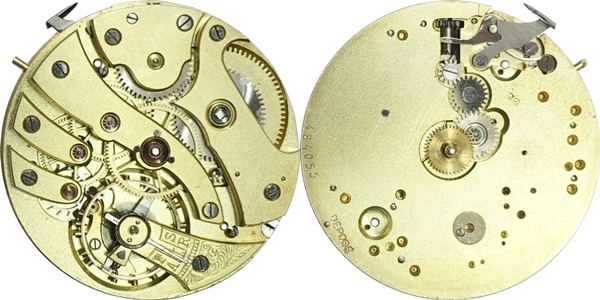
Movements for men’s pocket watches row 4/5

- Rekord mit Chaton (with Chaton = screw-set jewel)
19 lignes, Swiss lever escapement, bimetallic screw balance with Breguet hairspring, 16 jewels, small seconds, crown winding with lever.
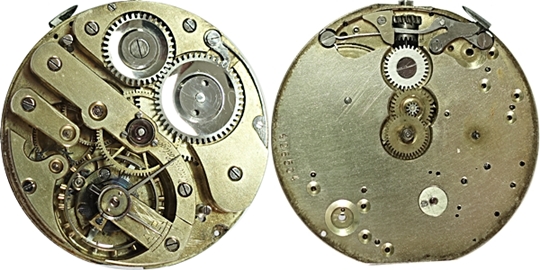
- Roland
18 lignes, cylinder escapement, 6 jewels, small seconds, rocking bar winding mechanism with pusher.

- Roland 4 à vue
18 1/2 lignes, cylinder escapement, 10 jewels, small seconds, crown winding with pusher.

- Roland Anker
19 lignes, lever escapement, monometallic screw balance, 11 jewels, small seconds, crown winding.

Movements for men’s pocket watches row 5/5

- Rolle 1
Cylinder escapement, 10 jewels, small seconds, crown winding with pusher.

- Rolle 2
18 lignes, cylinder escapement, 10 jewels, small seconds, crown winding with pusher, slightly different shape of the click spring than in the picture above.

- Romeo
Swiss lever escapement. - Standard I
Swiss lever escapement.


Have an Alpina 14K gold pocket watch with chain, UH number 106541, what can you tell me about it
Nothing, sorry.